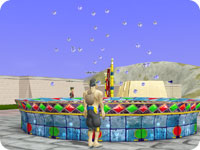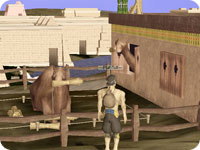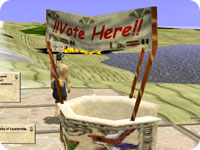Tips and Tricks
- Your character runs fastest along roads, so use them, instead of running over grass or sand, whenever possible. Once your dexterity skill reaches seven, however, you can run along any terrain without a penalty. Steep hills are an exception, though, so you’ll have to go around them no matter what.
- If you zoom all the way out by either spinning your mouse’s wheel or moving your pointer to the bottom of the screen, you’ll note that you can take in a wide expanse of territory all at once. If you need to travel a long distance, check out the bird’s eye view and click on the spot to which you want to run. Just make sure that your path doesn’t take you over undesirable terrain.
- Collect slate as often as you can, since it’s not as readily available as grass, mud and other beginning resources. You’ll find it near water; note that sometimes when you gather slate there will be more in the same spot, so don’t leave until you make sure you’ve exhausted what’s there.
- Once you become a citizen, find a good spot to build your compound, which will serve as your base camp and allow you to house your chests as well as your loom, wood plane and other tools. Try to find a clear spot near water, trees and grass, which will allow you to gather resources without competing with other players and without having to travel far to do so.
- When planting flax, try doing so in a large circle. You’ll notice that as the first bed starts to grow weeds, you can quickly clear them from all the beds. Remember that if you don’t clear the weeds, you won’t be able to harvest flax but you will be able to collect flax seeds — given that the School of Art only hands you a few seeds to start with, turn them into as many seeds as you can before you start growing and harvesting flax.
- The game’s most useful command is “/info.” Type it, plus the name of a player or guild, and press Return to pull up an information box. Most people in the game use coordinates to direct others to locations, and you’ll find those data points in the information boxes for most guilds.
- You can join as many guilds as you want, so do so to take advantage of the help many of their members offer. Just don’t forget to reciprocate when others need assistance. “Guilds now arise for specialized purposes,” notes Tepper. “Your list of guilds can function as a sophisticated reputation system. If another player walks up to you and sees that you are an elder in several respected guilds, that says a lot about your character.”
- If you click on yourself and then click “Navigation…” you’ll see “Landmarks…” an option that allows you to set and delete landmarks that only you can see. They can help you get around the map and ensure that you find your way back to your compound, guild hall or other important place.
Looking for more resources? Visit these Web sites:

Reflection.… Defeat seven players at this game to begin your tutelage in the School of Conflict.

Camel Call. You can even raise livestock such as camels.

Vote Early, Vote Often. A Demi-Pharaoh candidate engages in some last-minute campaigning.
You’ll soon learn that the number seven pops up frequently, thanks to the fact that it’s Tepper’s favorite number. While A Tale in the Desert doesn’t feature the levels statistic that such games as World of Warcraft do (i.e., “I’m a 30th level Undead Warlock”), your progress in the seven tests found in the seven disciplines serves a similar purpose. Here are the basics of each.
- Architecture: Building stuff is an important part of the game. Your first test as an architecture initiate is to construct a house. Eventually, you will learn the secrets of pyramid building, an arduous but rewarding task.
- Art: Your first test in this discipline is to create a sculpture that at least 20 passersby find appealing. Build it in a heavily trafficked area, of course, and remember that the sculpture’s base can only hold 24 items, so take care as you place them. Items can be partially buried in the ground, if that suits the aesthetics of your design.
- The Human Body: Begin your path through this discipline by running a course between different locations on the map within 20 minutes. Later you will learn and perform a variety of acrobatic moves and take on other tests that will increase your physical skills.
- Conflict: Challenge and defeat seven other players at the game Reflection, which is played at many of the pools found on the map. Reflection tests your spatial reasoning skills by presenting 32 bubbles and asking you to connect three of them into a triangle. Your opponent then does the same, but she can’t use any of the bubbles you used, nor can her triangle intersect any existing ones. The loser is the player who can’t form anymore triangles. Later tests expand your bluffing and deception skills, among others.
- Leadership: Create a petition recommending yourself as a leader and get 20 different characters to sign it. Later tests require you to mentor new players and help them gain citizenship status, among other tasks. The Demi-Pharaoh election is part of this discipline.
Thought: Invent a Set’s Ladder that achieves a popularity of 100 to begin this discipline. Set’s Ladder is a game played on a pyramid that has been rigged for that purpose. The basics of the game involve moving blocks to the top of the pyramid before your opponent does, but you can adjust the specifics to your liking. One character playing multiple Set’s Ladder games with your design will continue to earn you popularity points, but after seven games her contribution will be negligible, so you need many different characters trying out your game to succeed.
Some pyramid owners will rent out their constructions for games of Set’s Ladder; the Wiki in the Desert Web site lists many of their locations.- Worship: Find another initiate and successfully complete a sequence of blessings to various Egyptian gods to qualify as a Worshipper. The other initiate must be someone who hasn’t passed the first test yet. Later tests in this discipline include the Test of Marriage, which is simple to complete but automatically shares property between you and your marriage partner and allows both of you to log in as the other, so your real goal is to find another player you can trust. And, of course, divorce didn’t exist in ancient Egypt, so it doesn’t exist in A Tale in the Desert II either.
- Mac OS X version 10.3.9
- 750MHz PowerPC G4 processor or higher
- 512MB of RAM
- GeForce 4 MX video card
- Additional monthly fees required
